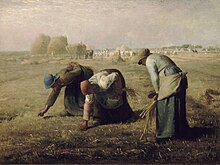
Gleaning is the act of collecting leftover crops in the field after harvest. During harvest, there is food that is left or missed often because it does not meet store standards for uniformity. Sometimes, fields are left because they were not economically profitable to harvest.[1][2] In modern times, gleaning is used to provide fresh foods to those in need. "Dumpster diving", when done for food or culinary ingredients, is seen as a similar form of food recovery.[3] There are multiple organizations that support gleaning, including the Gleaning Network in the UK, and the National Gleaning Project in the United States.[4][5] Both organizations have worked on national networks to connect modern gleaning and food recovery organizations.[4][5]
- ^ Sands, Crystal (2022-09-30). "'Tis the Season For Gleaning". Modern Farmer. Retrieved 2024-11-22.
- ^ Hussey, Stephen (1997). "'The Last Survivor of an Ancient Race': The Changing Face of Essex Gleaning". The Agricultural History Review. 45 (1): 61–72. JSTOR 40275132.
- ^ Marshman, Jennifer; Scott, Steffanie (January 2019). "Gleaning in the 21st century: Urban food recovery and community food security in Ontario, Canada". Canadian Food Studies. 6 (1): 100–119. doi:10.15353/cfs-rcea.v6i1.264. hdl:10012/9736. Retrieved 1 December 2020.
- ^ a b "About". Gleaning Network. Retrieved 2024-11-22.
- ^ a b "Laws, Resources, & Organizations for Gleaning & Food Recovery - National Gleaning Project". National Gleaning Project | Gleaning-related resources. 2018-12-11. Retrieved 2024-11-22.